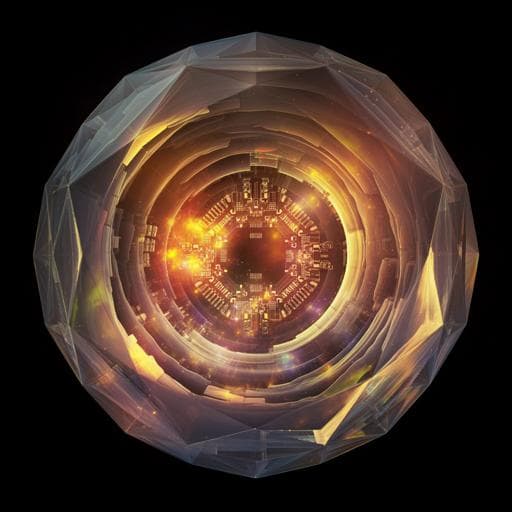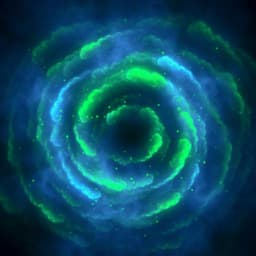
Physics
Bose-Einstein condensation of light in a semiconductor quantum well microcavity
R. C. Schofield, M. Fu, et al.
Dive into the groundbreaking discovery of Bose-Einstein condensation of photons in inorganic semiconductor microcavities, a major leap differentiating it from laser action. This research, conducted by Ross C. Schofield and colleagues, reveals the potential of these microcavities in enabling continuous operation and exploring the fascinating realm of superfluid light.
~3 min • Beginner • English
Introduction
The work addresses whether and how photons in an inorganic semiconductor quantum well microcavity can reach thermal equilibrium and undergo Bose-Einstein condensation at room temperature, and how this regime can be distinguished from conventional semiconductor lasing. Conventional semiconductor lasers rely on population inversion and typically operate out of thermal equilibrium, suggesting neither carriers nor photons are thermalized. However, quasi-thermal equilibrium of carriers and detailed balance can enable thermalized radiation. Prior BEC of photons was realized in dye-filled cavities via Kennard–Stepanov-like relations; exciton-polariton condensates exhibit ground-state coherence but often require cryogenic operation and dissociate at high excitation. The purpose here is to identify and engineer a regime in an inorganic III–V microcavity where the van Roosbroeck–Shockley relation evidences thermalization of carriers and photons, enabling photon BEC distinct from lasing. Demonstrating continuous, room-temperature photon BEC with stronger interactions would provide a robust platform for many-body photonic physics and practical coherent light sources with lower thresholds than lasers.
Literature Review
The study builds on demonstrations of photon thermalization and BEC in dye-filled microcavities, where the Kennard–Stepanov relation underpins thermal equilibrium between absorption and emission. BEC has been observed across bosonic systems (atomic gases, magnons, excitons, surface plasmon polaritons, and exciton-polaritons), but dye-based photon BECs can suffer from shelving into dark states necessitating pulsed operation, and polariton condensates are limited by exciton binding energies and dissociation at high pump powers. In semiconductors, the van Roosbroeck–Shockley (vRS) relation links absorption and emission under thermal equilibrium. Recent theory and experiments indicate photon thermalization and condensation may be achievable in semiconductor microresonators and VCSEL-like platforms, with predicted phase boundaries between BEC and lasing governed by the thermalization parameter γ = α/κ. Prior observations in electrically pumped semiconductor microresonators and theoretical models (e.g., Kirton & Keeling) motivate exploring open microcavities with controllable loss and absorption to access photon BEC.
Methodology
Device and materials: An open-access microcavity was assembled with one half consisting of a GaAs/AlAs distributed Bragg reflector (DBR) hosting a single 8 nm InGaAs quantum well (QW) near the surface, and the other half a commercial high-reflectivity concave DBR on a glass substrate (radius of curvature ρ = 0.2 m; also 0.1 m used for some measurements). The semiconductor DBR has R1 > 99.950% and the commercial mirror R2 > 99.995%, resulting in dominant emission through the GaAs substrate. The cavity was operated at longitudinal mode number q = 9 and stabilized interferometrically via imaging interference rings from an 840 nm LED and PID control on a piezo stage.
Sample growth (MBE): On GaAs(001) wafers, a 300 nm GaAs buffer, a 32.5-pair GaAs/AlAs DBR, cavity layer, the 8 nm InGaAs QW with GaAs cap, and surface layers (including a 5 nm AlAs window layer crucial for strong near-surface photoluminescence) were grown with controlled substrate temperatures validated by band-edge thermometry.
Optical excitation and detection: The QW was pumped with a 785 nm continuous-wave diode laser focused through the concave mirror. Emission was collected through the substrate side with imaging onto a camera and spectrometers. Momentum-resolved spectra were obtained with an imaging spectrometer and CCD. A 925 nm long-pass filter rejected bulk GaAs emission and pump light. A Michelson interferometer measured first-order temporal coherence.
Characterization of absorption/emission and thermalization: The QW emission and absorption spectra were first measured without the commercial mirror. Carrier-phonon intraband scattering at ~10^−13 s ensures thermal carrier distributions, producing an Urbach tail in absorption and a long-wavelength photoluminescence tail. The vRS relation was used to convert measured photoluminescence into the expected absorption; good correspondence was obtained for wavelengths λ > 935 nm after accounting for DBR mirror loss and a Gaussian bound-exciton absorption feature near 930 nm. This established a spectral region where carriers and phonons are in thermal equilibrium, a prerequisite for photon thermalization.
Cavity physics and model: The two-dimensional photon dispersion in the curved open cavity is E_ph(k_r, r) = m c^2 + (ħ^2 k_r^2)/(2 m) + (m Ω^2)/2 − m c^2 (r/ρ)^2, with photon mass m = ħ n / (c λ), trapping frequency Ω depending on cavity length and refractive index, and an interaction term represented via an intensity-dependent refractive index (n2, Kerr/free-carrier/heating contributions). The cavity loss rate κ ≈ (1.6 ± 0.2) × 10^10 s^−1 was inferred from threshold and reflection data and is consistent with mirror reflectivities. The thermalization parameter γ = α/κ was engineered by using a single QW to achieve α comparable to κ in the Urbach tail (approx. 935–960 nm). Theory predicts photon number spectra approaching a Bose–Einstein distribution with chemical potential μ(N) = E_fc − E_fv under good thermalization (γ ≳ 1), and BEC occurs when μ approaches the cavity ground-state energy.
Measurements and phase mapping: Emission spectra were recorded versus pump intensity at fixed cut-off wavelength λ_c (e.g., 950 nm). Below threshold, spectra were fit to Maxwell-Boltzmann/Bose–Einstein forms; at increasing pump, ground-state occupancy rapidly increased, identifying a critical intensity I_crit. Spatial images distinguished thermal clouds from condensed spots; momentum-resolved spectra mapped the filled parabolic dispersion and the k∥ ≈ 0 condensate. The pump spot position and size were varied to test spatial thermalization. A phase diagram of emission patterns versus λ_c and pump intensity was generated using unsupervised clustering of emission images, identifying thermal cloud, single-mode photon condensate, multimode condensation, and higher-order-mode lasing regimes.
Coherence and interactions: First-order temporal coherence was measured with a Michelson interferometer. Interaction effects were quantified by (i) the condensate radius versus intracavity condensate intensity I_c (fitting super-Gaussian radial profiles and using a trapping-energy versus nonlinear refraction balance) to extract n2 and a dimensionless interaction parameter g̃; and (ii) the condensate wavelength blueshift versus I_c to extract n2 and g. Data analysis followed equations presented (balance equations yielding Bose–Einstein-like spectra; relationships between condensate size/energy shift and n2).
Key Findings
- Thermalization window: The QW absorption and emission obey the van Roosbroeck–Shockley relation for λ > 935 nm when accounting for mirror losses and exciton absorption at 930 nm, indicating good carrier–phonon thermal equilibrium in this spectral range. The designed mirror stack centers λ_mbr ≈ 950 nm within this window.
- Cavity loss and reflectivity: Mirror reflectivities R2 > 99.995% (commercial) and R1 > 99.950% (semiconductor) yield κ ≈ (1.6 ± 0.2) × 10^10 s^−1, consistent with independent reflectivity estimates (κ > 10^10 s^−1). A single QW provides about −1.5% round-trip absorption peak, while mirror round-trip loss is <5 × 10^−4.
- Photon BEC at room temperature: For λ_c ≈ 950 nm (q = 9), below threshold the emission follows a thermal distribution; as pump increases, ground-state population rises sharply, and above the critical intensity I_crit ≈ 1 kW cm^−2 a photon BEC forms with dominant ground-state occupation and a saturated thermal tail. The condensate output is stable but shows sublinear increase at high pump due to heating.
- Thermalized photon gas: Momentum-resolved spectra of the thermal cloud (at 0.2 I_crit) show a filled parabolic dispersion consistent with the cavity model. Fitting yields a photon gas temperature T = 300 ± 30 K. The thermal cloud remains centered at the cavity minimum when the pump is displaced, evidencing spatial thermalization.
- Coherence and polarization: The first-order coherence time increases to >500 ps above threshold (>10 times longer than below threshold), with power dependence matching prior dye-BEC experiments and recent theory. The condensate is polarized with the pump, while the thermal cloud is unpolarized. The device emits ~300 μW for ~50 mW input under representative conditions, and the condensate can be sustained continuously with a range of cut-off wavelengths and pump parameters.
- Phase diagram and BEC–lasing boundary: A phase map versus λ_c and pump intensity identifies regimes: thermal cloud (below threshold), single-mode photon condensate (936 nm < λ_c < 957 nm), multimode condensation near λ_c ≈ 956.5 nm at higher pump, and higher-order-mode lasing for λ_c ≥ 957 nm. The transition to lasing correlates with decreasing γ below ~0.1 where absorption is insufficient to thermalize before cavity loss.
- Photon–photon interactions: Increasing intracavity condensate intensity I_c leads to (i) condensate radius expansion (repulsive effect) and (ii) condensate wavelength blueshift (higher energy). Extracted dimensionless interaction parameters are g̃ = 0.0025 ± 0.0004 (from size increase) and g = 0.0022 ± 0.0004 (from blueshift), larger than typical dye-based photon BEC values (g ≤ 10^−4). The repulsion indicates negative dn/dN attributable to free carriers in InGaAs QWs; heating alone (dn/dT > 0 in GaAs) would be attractive, so the observed net repulsion points to carrier-mediated nonlinear refraction. The study also reports an unoptimized interaction parameter g ≥ 10^3 in the abstract.
- Operational advantages: Inorganic semiconductors lack long-lived dark states, enabling continuous-wave operation. Operating in the Urbach tail allows below-inversion, ground-state condensation with controllable spatial trapping and lower critical behavior thresholds than lasers.
Discussion
The results directly demonstrate that photons in an inorganic III–V semiconductor open microcavity can thermalize and undergo Bose–Einstein condensation at room temperature, addressing the central question of whether semiconductor environments support photon BEC distinct from lasing. By engineering α/κ in the Urbach tail and using an open cavity with tunable cut-off wavelength, the experiment isolates a regime where the emission follows Bose–Einstein statistics with a well-defined chemical potential and transitions into a ground-state condensate at a critical pump intensity. The momentum-space measurements confirm thermalization of the photon gas, and the phase diagram maps the boundary between condensation and lasing, consistent with theoretical predictions linking γ to thermalization breakdown. The continuous operation and observed interactions substantiate semiconductors as robust platforms for quantum statistical condensates of light. The measured repulsive interactions, stronger than in dye-based systems, suggest access to rich many-body physics (e.g., superfluidity) and functionality (e.g., spatially shaped potentials and Josephson effects), while continuous operation and ground-state robustness highlight potential for efficient coherent sources and quantum technologies under ambient conditions.
Conclusion
This work establishes an inorganic semiconductor quantum well open microcavity as a robust, tunable platform for photon Bose–Einstein condensation at room temperature, with clear discrimination from lasing via thermalization control and phase mapping. Key contributions include: (i) identification of a spectral thermalization window (λ > 935 nm) where vRS holds; (ii) observation of thermalized photon gases and BEC with a critical intensity near 1 kW cm^−2 and coherence times >500 ps; (iii) a phase diagram delineating BEC, multimode condensation, and lasing; and (iv) evidence of repulsive, carrier-mediated photon–photon interactions with dimensionless strengths ~2 × 10^−3. These advances demonstrate continuous, ground-state operation with comparatively low thresholds and stronger interactions than dye-based photon BECs, opening a path to explore superfluid light, vortices, and Josephson physics in engineered potentials at room temperature. Future work could optimize device design to mitigate heating, enhance interactions (e.g., through beam-size engineering, excitation wavelength choice, cavity mode order reduction, or multiple QWs), and elucidate microscopic interaction mechanisms (carrier dispersion, inhomogeneity, bandgap renormalization, and dynamical timescales).
Limitations
- Thermalization is limited spectrally: vRS breaks down near the exciton absorption peak (~930 nm) and at longer wavelengths where cavity loss overtakes absorption (γ < 0.1), leading to lasing rather than BEC.
- Heating effects at high pump intensities cause deviation from linear output and could partially mask or counteract interaction signatures (GaAs dn/dT > 0 implies attractive thermal nonlinearity).
- Interaction mechanisms are not fully resolved; multiple carrier-related processes (dispersion, inhomogeneity, bandgap renormalization) may contribute, requiring further study for quantitative comparison with other photon condensates.
- The reported interaction strengths are extracted under assumptions (e.g., using super-Gaussian fits, peak intensity estimates) and represent lower bounds; systematic uncertainties remain.
- The device is not fully optimized; improvements in cavity design, pump geometry, and thermal management are needed to maximize interaction strengths and stability across broader operating conditions.
Related Publications
Explore these studies to deepen your understanding of the subject.







